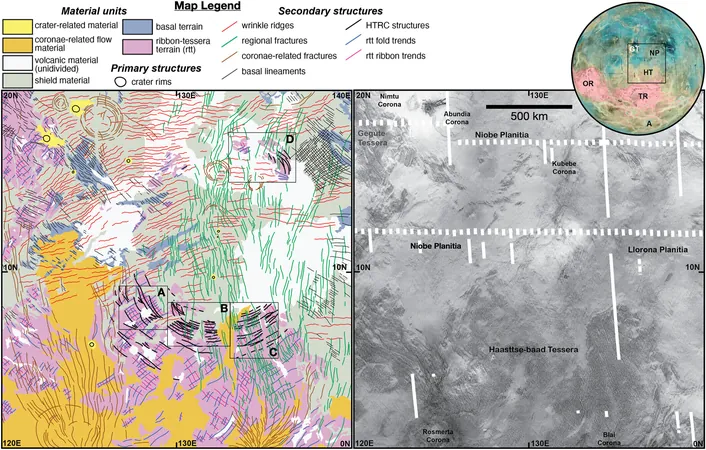
Unearthing Venus: Is the Haasttse-baad Tessera Evidence of Cataclysmic Impacts?
2024-11-05
Author: Daniel
Summary
A groundbreaking study led by a trio of expert geologists and environmental scientists from Universidad Rey Juan Carlos, Lawrence Livermore National Laboratory, and the University of Minnesota has unveiled compelling evidence that could rewrite the history of our neighboring planet, Venus.
Their research indicates that the Haasttse-baad Tessera, a significant geological feature on Venus, likely formed as a consequence of two massive impacts that occurred during the planet's formative years.
Research Details
In their recent publication in the Journal of Geophysical Research: Planets, researchers Iván López, Evan Bjonnes, and Vicki Hansen detail their innovative approach, combining geological relations with advanced numerical modeling to explore the origins of this ancient terrain.
Unlike other bodies in our solar system, Venus has remained mysterious; previous studies revealed that the planet lacks large impact craters exceeding 300 kilometers in diameter.
Intrigued by this anomaly, the researchers hypothesized that the formation could be traced back to an even larger cataclysmic event.
Methodology
To test their theory, the team conducted a meticulous analysis of the Haasttse-baad Tessera's dimensions, comparing it to the notable multi-ring structure found on Callisto, one of Jupiter's moons.
Scientists had previously established that Callisto’s unusual surface feature was the result of a massive impact, where chilled water erupted from below the crust, leading to the distinct ring formations.
By drawing parallels between the two celestial bodies, the researchers employed numerical modeling techniques to investigate the potential origins of the concentric circles observed on Venus.
Findings
Their findings were astonishing.
The modeling suggested that shortly after its formation, Venus developed a thin crust over a still-molten surface.
An asteroid or another significant celestial body colliding with Venus would have penetrated this surface, forcing molten materials upward and reshaping the crust in a manner reminiscent of what has been observed on Callisto.
This violent interaction could plausibly account for the concentric circles that now adorn the planet’s surface.
Moreover, evidence uncovered during their analysis revealed some of these circles were misaligned, indicating that Venus might have endured impacts from not one but two sizable objects—each approximately 75 kilometers wide—striking in close succession at the same location.
Speculations
Further exploration into the nature of Haasttse-baad Tessera led the researchers to speculate that it is not perched atop a plateau as is the case with other comparable formations.
Instead, they propose that subsurface material drained away before solidifying, calling into question our understanding of the geological processes that shape planets.
Conclusion
With these astonishing discoveries, the study not only sheds light on the tumultuous history of Venus but also invites a reevaluation of impact events across the solar system.
As we delve deeper into our cosmic neighborhood, the mysteries of Venus continue to challenge our perceptions, emphasizing the need for further exploration and study.
Is Venus the key to unraveling more secrets of our solar system's past? Only time will tell!



 Brasil (PT)
Brasil (PT)
 Canada (EN)
Canada (EN)
 Chile (ES)
Chile (ES)
 España (ES)
España (ES)
 France (FR)
France (FR)
 Hong Kong (EN)
Hong Kong (EN)
 Italia (IT)
Italia (IT)
 日本 (JA)
日本 (JA)
 Magyarország (HU)
Magyarország (HU)
 Norge (NO)
Norge (NO)
 Polska (PL)
Polska (PL)
 Schweiz (DE)
Schweiz (DE)
 Singapore (EN)
Singapore (EN)
 Sverige (SV)
Sverige (SV)
 Suomi (FI)
Suomi (FI)
 Türkiye (TR)
Türkiye (TR)